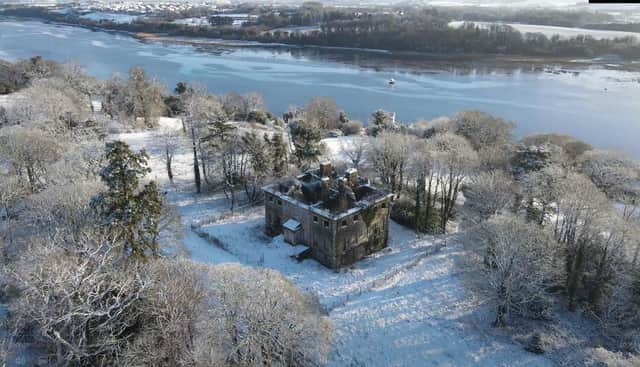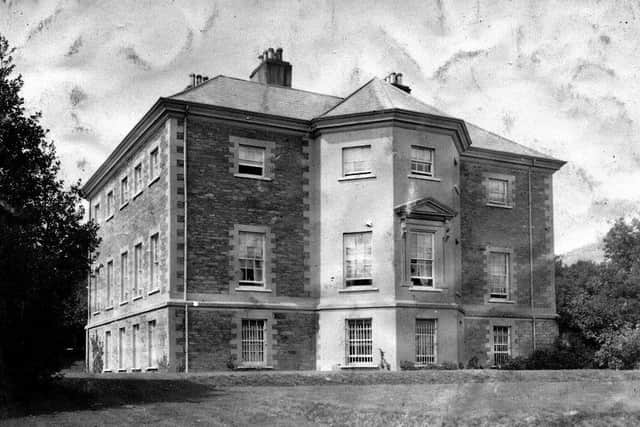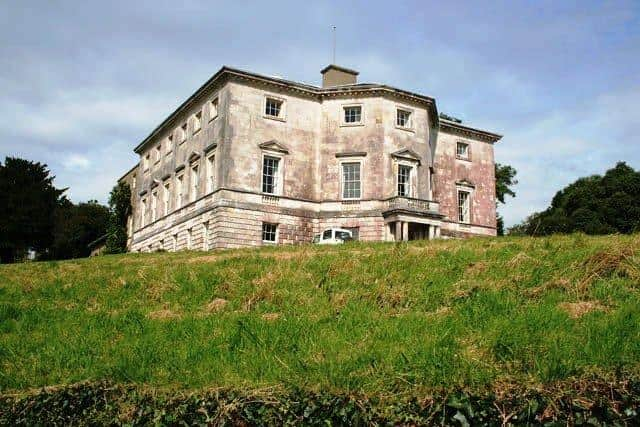The importance of being Boomhall: a very special place for Derry


Boomhall estate is one of the most important historic properties owned by Derry City and Strabane District Council.
On the west bank of the river, less than a mile from the city walls and immediately beyond the west escarpment of Foyle Bridge, the place has survived, already for some two and a half centuries, unmolested by change and substantially intact.
Advertisement
Hide AdAdvertisement
Hide AdThough the house was set alight by vandals and left to burn in the 1970s, its walls were never destroyed. Their excellent and ingenious masonry, formed of sandstone and schist that is lined with brick, still stands today, just as it did in the summer of 1777 when the masons had finished their work.


There is no doubt, therefore, that the building can be restored and put to good use in answering the needs and requirements of many different groups of people in the modern world, both in Derry and in the surrounding counties.
In considering what might be the best future for Boomhall in 2022, the state of the mansion house offers a challenge - but it is not an insuperable problem and may help to focus attention on the most vital question posed by the estate today: ‘the Importance of being Boomhall’.
What is Boomhall? There is no simple answer, but we might state, as a start, that it is an extensive and attractive open space, in a beautiful situation on the banks of the Foyle, easily accessible by foot both from the centre of the city and from Carnhill, Shantallow, Culmore and the Waterside.
Advertisement
Hide AdAdvertisement
Hide AdIn environmental terms, Boomhall provides the habitat for a wide variety of wildlife: its fields, woodlands, grounds and gardens contribute widely to the biodiversity in the area while its pathways and the river foreshore are constantly in use both by people walking in the estate and by joggers.


Viewed from the height of Culmore roundabout, the land steps down in gradual undulations towards the northeast. Some 60 acres in extent, much is open fields and pasture where horses graze, but Boomhall is also a designed landscape, remarkable for the number of mature trees planted in the eighteenth century which still survive, for the lines of old avenues and for a plantation – once called ‘the Grove’ – set between the stables and the mansion house.
All these features appear in the map in The First Ordnance Survey of the estate, in 1835, which clearly shows the extent to which the natural characteristics of the site were enhanced by Georgian designers to create a beautiful landscaped park as a setting for the house.
In addition to its landscape and ‘open air’ value, Boomhall enjoys unique importance as an historic battle site. One of the most popular Irish guides ever published, The Post-chaise Companion through Ireland, printed in 1786 soon after the building was finished, explains that Boomhall was ‘so called because just under the house the boom was fixed, which the French and Irish armies threw across the River Foyle, to prevent relief from coming up the river’ when they besieged the city in 1689.
Advertisement
Hide AdAdvertisement
Hide AdThe Boom stone is on the estate and also a well of fresh water, known as King James’s Well, recording the fact that the last Stuart monarch reputedly encamped by the well and stationed much of the Irish army here before and during the time of the siege. So, Boomhall really is an historic battle site whose content and full significance has yet to be revealed.


The architecture on the estate is, perhaps, what most people will think of when Boomhall is mentioned. The mansion house is an important historic building even if, currently, it is just a shell. There is a detached courtyard of stables and estate buildings nearby and, adjacent to the stables, one of the largest walled gardens ever built in Ireland.
An historic house can only justify the term when members of the same family live in it for many years, so that their story is woven into and becomes part of the fabric of the building. In the case of Boomhall, there are two such families: the Alexanders and the Bairds. The Alexanders, who came from Scotland and settled in Limavady in the seventeenth century, later became important merchants in Derry, with a house in the Diamond. By 1755, when Nathaniel Alexander was elected an alderman of the city, his third son, James, had already embarked on a lucrative career as an officer of the East India Company. James worked with dedication; he served as a member of Council in Madras for eleven years, became Military Paymaster there and, after a brief return to Ireland in 1763, spent a further six years in Calcutta, from 1767 to 1772. He returned to Ireland as a man of immense wealth and it was he who undertook the construction of Boomhall.
An extraordinary family story is interwoven with the history of the estate for James’s ambition did not rest in the creation of a fashionable villa by the banks of the Foyle. Soon after his return from India, he purchased a second, much larger, estate at Caledon in Co.Tyrone and, in 1784, he bought a house in Dublin for use while serving in Parliament as MP for Derry.
Advertisement
Hide AdAdvertisement
Hide AdIn 1790, James was created an Irish peer with the title Baron Caledon, advanced to Viscount in 1797 and, then, Earl in 1800. Ironically, almost as soon as Boomhall was built, James’s focus shifted, as a landed proprietor, to Co. Tyrone and, as a politician, to Dublin. When this happened, the person who became responsible for Boomhall was his brother, Robert, eight years older than James himself, a merchant in Derry who had been responsible for supervising the construction of the house, at least until the building was roofed.
Under an agreement, made between the brothers in November 1779, Robert and his wife Anne were given a life interest in the building, its pleasure grounds and estate for the tiny rent of ten shillings a year. And, so, it came about that Robert and his family of five sons and two daughters became the first inhabitants of Boomhall.
When Anne Alexander died there in 1817, her nephew, Du Pré Alexander, the second Earl of Caledon, would have been free to sell the house but he chose, instead, to let the building which for many years was occupied by the Bishop of Derry and Raphoe.
Boomhall passed out of the control of the Alexander family in October 1849 when it was sold by the third Lord Caledon to Daniel Baird, a leading shipowner in Derry who was also Harbour Master for many years. The price was £6,000.
Advertisement
Hide AdAdvertisement
Hide AdMembers of the Baird and Maturin-Baird family owned the estate until November 1949 when it was purchased for just £3,000 by Michael Henry McDevitt who had been a tenant in the house for many years.
When Mr. McDevitt died intestate in Coleraine hospital in May 1968, Boomhall was deemed to have been inherited by his niece, Helen Mary McCann, of Blackrock, Co. Cork, who was the owner of the estate at the time that the mansion house was set on fire. The land at Boomhall, including the stables and walled garden, was sold by Mrs. McCann to Derry City Council in March 1996.
While it is often the case that little is known about an historic building in Ireland, an essential element in the significance of Boomhall is that the estate is very fully documented, both by the papers of the Alexander and Baird families, which have been deposited in the Public Record Office of Northern Ireland in Belfast, and by a succession of title deeds which are held by the Council.
With such a rich and particular cultural history, the Boomhall Trust believes that any plans which are put forward for the future of the estate must be responsible and holistic, acknowledging and reflecting each of the complex layers of the natural environment, of landscape and of national and family history which come together to create a rich and unique identity for this site - the importance of being Boomhall. This is a very special place for Derry.
Advertisement
Hide AdAdvertisement
Hide AdThere is one further aspect of the challenge that the estate presents: the international importance of its architecture.
As an architectural design, Boomhall is austere but it is, also, a house of great quality in which every element of each façade is scrupulously considered.
Today it is widely accepted as the work of Sir Robert Taylor (1714-88), one of the leading architects in London in the reigns of George II and George III, who made a particular contribution to architecture in Great Britain through the development of a class of neat suburban villas, perfectly considered and standing on their own like a piece of solid geometry, frequently - as at Boomhall - with a large bay window as a feature of the garden front.
Taylor’s patrons came for a wealthy clientele of city merchants, financiers, bankers and members of the East India Company - a group into which James Alexander fits perfectly.
Advertisement
Hide AdAdvertisement
Hide Ad○ Professor Alistair Rowan is a director of Boomhall Trust which has been established to restore the mansion house, stables, walled garden and landscapes at Boomhall. Alistair taught in the Department of Fine Art at the University of Edinburgh between 1967 and 1977; was Professor of the History of Art in UCD from 1977 to 1990; Slade Professor of Fine Art at the University of Oxford in 1988; and Principal of the Edinburgh College of Art from 1990 to December 2000. On leaving Edinburgh, he was invited to set up a new department of the History of Art in University College Cork, where he taught until September 2003. Prof. Rowan was chairman of the Irish Architectural Archive from 1980 to 1986; President of the Society of Architectural Historians of Great Britain from 1992 to 1995 and President of the Architectural Heritage Society of Scotland from 1992 to 2010. He served for 8 years on the Historic Buildings Council for Scotland reporting to the Secretary of State for Scotland on the care of Scottish Historic Buildings (1988 to 1996). He is the founding editor and author of two volumes of the Pevsner Architectural Guides, ‘The Buildings of Ireland’, published by Yale University Press. These are North West Ulster (1978) and North Leinster (1991).